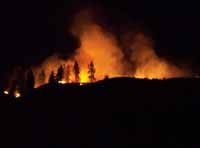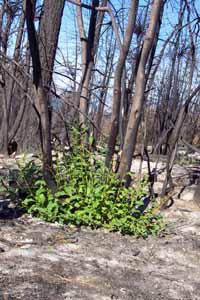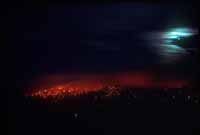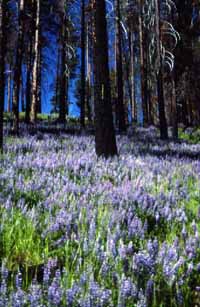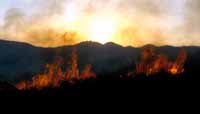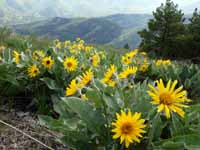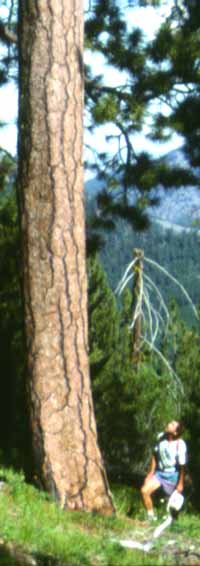Fire Ecology
What is fire ecology?
Fire ecology is a branch of ecology that focuses on the origins of wildland fire and it’s relationship to the environment that surrounds it, both living and non-living. A wildland fire is defined as any fire that is burning in a natural environment. Fire ecologists recognize that fire is a natural process, and that it often operates as an integral part of the ecosystem in which it occurs.
The main factors that are looked at in fire ecology are fire dependence and adaptation of plants and animals, fire history, fire regime and fire effects on ecosystems.
Fire dependence
In the 1930’s, researchers in the southern United States argued against the negative perspective that has surrounded fire, with the belief that all fire is bad. It was realized that the devastating picture painted by huge-scale fires produced fear in the minds of the public (and in politicians and scientists alike), and that this generated detrimental results in response to any wildland fires. These researchers recognized that there are species of plants that rely upon the effects of fire to make the environment more hospitable for regeneration and growth. Fire in these environments prepares the soil for seeding by creating an open seedbed, making nutrients more available for uptake and often killing plants that are invading into the habitat and competing with native species.
Fire history
Fire history deals with how often fires have occurred in a given geographical area. Through recorded history, we can see into the recent past, but trees are our source of information on fires in the distant past. Trees record their history through a system of growth rings that develop on the trees each year. When a fire goes through an area, the growth rings of that particular tree may be scarred. On live trees this is called a fire scar. Fire scars can also be seen on dead trees. Tree origin dates (calculated from the total number of rings) can also tell when fires occurred, in that fires gave way for these new trees to develop. The study of growth rings is called dendrochronology. Utilizing dendrochronology, we can determine when fires have occurred in the past, and sometimes determine their intensity and direction as well as other information about the weather patterns in that era.
Fire regime
Fire regime refers to the patterns of fire that occur over long periods of time, and the immediate effects of fire in the ecosystem in which it occurs. There are many ways to define a fire regime. Fire regime is a function of the frequency of fire occurrence, fire intensity and the amount of fuel consumed. The frequency is determined largely by the ecosystem characteristics, the duration and character of the weather (whether the season is drier or wetter than normal, etc.) and ignition sources. The intensity of a fire is determined by the quantity of fuel available, the fuel’s combustion rates and existing weather conditions. Interactions between frequency and intensity are influenced by wind, topography and fire history. There are many other factors that can come into play when talking of fire regimes, though this simple definition will work for most cases.
Causes of fire
Approximately 90% of fires in the last decade have been human-caused, either through negligence, accident or intentional arson. Some of the fires caused by accidents and negligent acts are through unattended campfires, sparks, irresponsibly discarded cigarettes and burning debris. The remaining 10% of fires are caused by lightning strikes, which are especially prevalent in the Western United States and Alaska.
Benefits/Disadvantages of Wildland Fire
Benefits:
The ecological benefits of wildland fires often outweigh their negative effects. A regular occurrence of fires can reduce the amount of fuel build-up thereby lowering the likelihood of a potentially large wildland fire. Fires often remove alien plants that compete with native species for nutrients and space, and remove undergrowth, which allows sunlight to reach the forest floor, thereby supporting the growth of native species. The ashes that remain after a fire add nutrients often locked in older vegetation to the soil for trees and other vegetation. Fires can also provide a way for controlling insect pests by killing off the older or diseased trees and leaving the younger, healthier trees. In addition to all of the above-mentioned benefits, burned trees provide habitat for nesting birds, homes for mammals and a nutrient base for new plants. When these trees decay, they return even more nutrients to the soil. Overall, fire is a catalyst for promoting biological diversity and healthy ecosystems. It fosters new plant growth and wildlife populations often expand as a result.
Disadvantages:
Fire can cause soil damage, especially through combustion in the litter layer and organic material in the soil. This organic material helps to protect the soil from erosion. When organic material is removed by an essentially intense fire, erosion can occur. Heat from intense fires can also cause soil particles to become hydrophobic. Rainwater then tends to run off the soil rather than to infiltrate through the soul. This can also contribute to erosion. In actuality, the negative effects of fires on soils are often exaggerated, and many fairly intense fires in western United States forests cause little soil damage. There is also the potential for alien plants to become established after fire in previously uninfested areas.
Fire suppression/Exclusion Policies
Wildfire behavior and the effect of fire-exclusion policies on vegetation composition and structure varies considerably (Smith and Fischer 1997). A substantial amount of attention has been paid to the development of dense stockings of small trees in some forests, and the contribution thereof to current fire severity in those areas. Although this is generally true of drier vegetation ecosystems, this observation does not always apply to many of the wetter and colder forests that dominate much of the northern Rockies and the Pacific Northwest. Nor does it apply to non-forested areas. The frequency of fire historically varies considerably depending upon the type of vegetation in a given ecosystem. The ecological effects of wildfire suppression policies instituted in 1911 have also varied with vegetation type.
In low-elevation ponderosa pine (Pinus ponderosa) and dry Douglas fir (Pseudotsuga menziesii) forests, average fire intervals have historically ranged from 5 to 20 years, and low to medium intensity fires were common (Arno 1980, Smith and Fisher 1997). Fire suppression has been fairly effective in reducing the number of fire cycles that these low elevation dry coniferous forests have experienced since the onset of fire suppression (Mutch 1994). This suppression of fire often leads to more intense fires in these areas when fires do occur, due to the build-up of fuel and conditions that are conducive to severe fire hazards.
Many dry coniferous forests have now missed several fire cycles (Mutch 1994). Due to their accessibility, these forests have also been extensively managed for timber production and livestock grazing. The ecological consequences of these management activities have caused a fairly dramatic change in tree density and forest composition (Smith and Fischer 1997). These changes have often created stands of dense, small-diameter trees in areas that used to be dominated by widely spaced old-growth trees. Past management activities have clearly created a situation in which a greater concentration of fuel is present, and there is a higher probability of high-intensity fire, should a wildfire spread into or start in the area.
In contrast to the dry forests, subalpine forests composed mainly of subalpine fir (Abies lasiocarpa), lodgepole pine (Pinus contorta var. latifolia), Engelmann spruce (Picea engelmannii) and whitebark pine (Pinus albicaulis) cover vast expanses of landscape. These forests are situated at higher elevations, which are considerably wetter and colder than the dry forests discussed above. Some of the conifer species present in sub-alpine forests are killed by moderate-intensity fire (Bradley, et al. 1992). In contrast, lodgepole pine, which is a dominant species in some sub-alpine forests, often reproduces prolifically following wildfire (Agee 1993). This is due to the serotiny of its cones. Some of the lodgepole pine cones are sealed shut by a resinous substance. These cones often remain on the tree for years at a time, and the seeds are only released when the resin is melted (at temperatures of 113-140 °F) during forest fires.
Subalpine forests typically burn rather infrequently, though often at a much higher intensity than do dry forests. A few subalpine forest types (e.g. white-bark pine) experience more frequent fire (Smith and Fisher 1997) but are very limited in distribution (less than 18% of the sub-alpine forests in the northern Rockies). Historic fire-return intervals in subalpine forests range from 50 to 300 years (Arno 1980, Smith and Fisher 1997, Agee 1990, Agee 1993). In many cases, historic fire-return intervals for subalpine forests are longer than the period of time in which the current fire-exclusion policies have been in effect. Fire exclusion due to wildfire-suppression activities has not yet measurably altered the structure and composition of the subalpine forests since they have, in general, not missed fire cycles like the dry forests have. (Smith and Fisher 1997).
In the northern Roackies, between the low-elevation dry forests and subalpine forests, a mid-elevation zone of forest, composed of Douglas-fir (Pseudotsuga menziesii), grand fir (Abies grandis), subalpine fir (Abies lasiocarpa), lodgepole pine (Pinus contorta var. latifolia), red cedar (Thuja plicata), western hemlock (Tsuga heterophylla), western larch (Larix occidentalis) and other species, is found. The fire regimes and historic fire-return intervals for these forests vary considerably with location and forest type (Arno 1980, Bradley, et al. 1992, Smith and Fischer 1997). Historic fire-return intervals range from 25 years to over 250 years in these stands (Arno 1980, Smith and Fisher 1997). Montane forests, generally, have been substantially affected by forest-management activities (primarily logging). These management activities and fire exclusion effects have largely varied within the diverse regions of montane forests in the western United States. In some areas, the effects have been subtle and slow to develop, while in other areas fire exclusion has lead to the development of dense understory vegetation and changes in forest composition (Smith and Fisher 1997).
Do severe wildfires burn in areas that are not composed of dense forests resulting from fire exclusion and other land management activities?
In the western United States, many areas that are not forested or only sparsely forested often experience severe wildfires. Many of the wildfires that burn each year burn in non-forested areas or involve substantial acreage of forests with sparse tree cover. In these areas, forest-thinning programs are inappropriate (due to a lack of trees) or would have little effect on fire behavior, because the tree density is already low. In a study performed by the Pacific Biodiversity Institute during the summer of 2000, seven recent major fires were examined that clearly illustrate this point: the Kate’s Basin Fire, the Canyon Ferry Fire Complex, the Mule Dry Creek Fire, the Hanford Fire, the Eastside Fire Complex, the Maudlow–Toston Fire, and the Maloney Creek Fire. These fires all burned through areas that included large portions of land that were not composed of dense forests. This year (2001), most of the large fires are burning in desert and sparsely forested country. Examples of this are: the Sheepshead Fire (Oregon), the Lakeview Complex (Oregon), the Sheep Complex (Nevada) and the Elk Mountain Complex (South Dakota and Wyoming).
In the northern Rocky Mountains, there are many areas that regularly experience severe wildfires that are not in densely forested areas. Persistent seral shrubfields are widespread in this region, a good example of which, are the "large expanses of shrub-dominated slopes, where tree regeneration is sparse or lacking, that characterize many areas in northern Idaho (Smith and Fisher, 1997)." Severe reburns are the main cause of these persistent shrubfields. Some of these shrubfields have persisted for 200 years or more, and have a mean fire-return interval of about 31 years (Barrett 1982). It is clear that persistent shrubfields are a product of wildfires burning in an environment where forest thinning would have little benefit.
Could extensive thinning of forests have prevented the current fire situation?
Silvicultural thinning (i.e., logging of small-diameter trees to reduce tree densities and/or underbrush) has been posited as a possible treatment method for reducing wildfire risk. Although thinning to reduce fuel load has received much media attention recently, it is controversial among the scientific community and remains largely untested (Henjum, et al. 1994, DellaSala, et al. 1995, SNEP 1996). There have been few empirical studies looking at the effectiveness of thinning as a treatment for reducing wildfire hazard (Frost 1999). The studies that have been conducted have reported highly variable results. Some studies indicate that thinning treatments designed to reduce fire risk actually increase the risk and severity of the fires (Huff, et al. 1995, van Wegtendonk 1996, Weatherspoon 1996). Although these treatments may reduce the flammable biomass in the area, they also lead to drier forests and higher winds (Countryman 1955, Agee 1997). Additionally, silvicultural treatments, even when conducted carefully, can lead to the following adverse conditions (excerpted from Frost 1999):
- Damage to soil integrity through increased erosion, compaction, and loss of litter layer (Harvey, et al. 1994, Meurisse and Geist 1994).
- Increased mortality of residual trees due to pathogens and mechanical damage to boles and roots (Hagle and Schmitz 1993, Filip 1994)
- Creation of sediment that may eventually be delivered to streams (Beschta 1978, Grant and Wolff 1991)
- Increased levels of fine fuels and near-term fire hazard (Fahnestock 1968, Weatherspoon 1996, Wilson and Dell 1971, Huff, et al. 1995)
- Dependence on roads, which result in numerous adverse effects (Henjum, et al. 1994, Megahan, et al. 1994)
- Reduced habitat quality for sensitive species associated with cool, moist micro-sites or closed-canopy forests (FEMAT 1993, Thomas, et al. 1993)
Fires also burn in US Forest Service Inventoried Roadless Areas and designated Wilderness Areas. Many of the forests in these areas have not been severely altered from their historic fire regimes, and are difficult to access due to steep, rugged topography. Widespread thinning of backcountry areas is likely to be extremely costly, cause extensive environmental damage and create little benefit to society. Thus, the cost involved and the environmental disturbances of applying mechanical treatments over large roadless areas are not justified.
Thinning of small diameter trees in dense, young forests may be appropriate and result in reduction of wildfire risk to human communities in certain situations. The most appropriate place to apply forest thinning is in dry forest types adjacent to human communities threatened by wildfires. In these areas, it may be appropriate to thin dense stands of young trees close to homes and community resources. Such thinning needs to be followed up by a program of regular prescribed burning in order to be effective. More research is needed on the efficacy of thinning programs for wildfire risk reduction before there is conclusive evidence to decide on their benefits or disadvantages.
What kinds of large-scale management practices should be implemented to reduce wildfire risk? Where should these take place, if they should?
Large-scale management practices are necessary to control the risk of wildfire in the interface between forested and rural landscapes. The effects of fire suppression and the potential for severe wildfire are greatest in these areas. While rural-forest interfaces occur in many different forest types, they are most common in dry and montane forests that have been the most altered from their historic fire regimes by past management activities.
Many researchers and scientists agree that the best way to reduce wildfire risk in the rural-forest interface is through the reintroduction of fire to many natural ecosystems (Walstad, et al. 1990, Mutch 1994, USDA/USDI 1995, Arno 1996, Frost 1999). Prescribed fire appears to be the most effective means for controlling the rate of spread and severity of wildfire (van Wegtendonk 1996, Stephens 1998). Prescribed fire as a management tool has been increasingly used; however, more burning is necessary to restore many ecosystems to their historic fire regimes, thereby preventing the chance of an intense, large-scale wildland fire (Mutch 1994, UDSA/USDI 1995, Arno 1996, Wright and Bailey 1982). The success of prescribed fire lies in keeping the fire under control. In some instances, mechanical treatments (e.g., thinning) may be applied to reduce the fuel loads to a point at which prescribed fires can be effectively controlled (Mutch 1994).
References
Agee, J.K. 1990. The historical role of fire in Pacific Northwest forests. Pp 25-38 In Walstad, J. et al. (eds.). Natural and prescribed fire in Pacific Northwest forests. Oregon State University Press. Corvallis, OR.
Agee, J.K. 1993. Fire ecology of Pacific Northwest forests. Island Press, Washington, D.C.
Arno, S.F. 1980. Forest fire history of the northern Rockies. Journal of Forestry 39:726-728.
Arno, S.F. 1996. The seminal importance of fire in ecosystem management -- impetus for this publication. in The Use of Fire in Forest Restoration. USDA Forest Service General Technical Report INT-GTR-341. Intermountain Research Station, Ogden, UT.
Beschta, R.L. 1978. Long-term patterns of sediment production following road construction and logging in the Oregon Coast Range. Water Resources Research 14: 1011-1016.
Bradley, A.F., W.C. Fischer, and N.V. Noste. 1992. Forest ecology of the forest habitat types of eastern Idaho and western Wyoming. USDA Forest Service Gen. Tech. Rep. INT-290.
Countryman, C.M. 1955. Old-growth conversion also converts fire climate. U.S. Forest Service Fire Control Notes 17(4): 15-19.
DellaSala, D.A., D.M. Olson and S.L. Crane. 1995. Ecosystem management and biodiversity conservation: Applications to inland Pacific Northwest forests. Pp. 139-160 in: R.L. Everett and D.M. Baumgartner, eds. Symposium Proceedings: Ecosystem Management in Western Interior Forests. May 3-5, 1994, Spokane, WA. Washington State University Cooperative Extension, Pullman, WA.
Fahnestock, G.R. 1968. Fire hazard from pre-commercially thinning ponderosa pine. USDA Forest Service, Pacific Northwest Region Station, Research Paper 57. Portland, OR. 16 pp.
Filip, G.M. 1994. Forest health decline in central Oregon: A 13-year case study. Northwest Science 68(4): 233-240.
Forest Ecosystem Management Assessment Team (FEMAT). 1993. Forest Ecosystem Management: An ecological, economic, and social assessment. Report of the Forest Ecosystem Management Assessment Team. July 1993. Portland, OR.
Frost, E. 1999. The scientific basis for managing fire and fuels in national-forest roadless areas. World Wildlife Fund. CFR 64 No 201.
Grant, G.E., and A.L. Wolff. 1991. Long-term patterns of sediment transport after timber harvest, western Cascade Mountains, Oregon, USA. Pages 31-40 in Sediment and stream water quality in a changing environment: Trends and explanations. IAHS Publication 203. Proceedings of the Symposium, 11-24 August 1991, Vienna, Austria.
Hagle, S., and R. Schmitz. 1993. Managing root disease and bark beetles. Pages 209-228 in T.D. Schowalter and G.M. Filip eds. Beetle-Pathogen Interactions in Conifer Forests. Academic Press, New York.
Harvey, A.E., J.M. Geist, G.I. McDonald, M.F. Jurgensen, P.H. Cochran, D. Zabowski, and R.T. Meurisse. 1994. Biotic and abiotic processes in Eastside ecosystems: the effects of management on soil properties, processes, and productivity. General Technical Report PNW-GTR-323, U.S. Forest Service, Pacific Northwest Research Station
Henjum, M.G., J.R. Karr, D.L. Bottom, D.A. Perry, J.C. Bednarz, S.G. Wright, S.A. Beckwitt, and E. Beckwitt. 1994. Interim protection for late-successional forests, fisheries, and watersheds: National forests east of the Cascades crest, Oregon and Washington. The Wildlife Society Technical Review 94-2, Bethesda, MD. 245 pp.
Huff, M.H., R.D. Ottmar, E. Alvarado, R.E. Vihnanek, J.F. Lehmkuhl, P.F. Hessburg, and R.L. Everett. 1995. Historical and current landscapes in eastern Oregon and Washington. Part II: Linking vegetation characteristics to potential fire behavior and related smoke production. USDA Forest Service Pacific Northwest Forest and Range Experiment Station, PNW-GTR- 355. Portland, Oregon.
Megahan, W.F, L.L. Irwin, and L.L. LaCabe. 1994. Forest roads and forest health. Pages 97-99 in R.L. Everett, ed. Volume IV: Restoration of stressed sites, and processes. General Technical Report PNW-GTR-330, U.S. Forest Service, Pacific Northwest Research Station.
Meurisse, R.T. and J.M. Geist. 1994. Conserving soil resources. Pages 50-58 in R.L. Everett, ed. Volume IV: Restoration of stressed sites, and processes. General Technical Report PNW-GTR-330, U.S. Forest Service, Pacific Northwest Research Station Mutch, R.W. 1994. Fighting fire with prescribed fire a return to ecosystem health. Journal of Forestry 92(11): 31-33
Smith and Fisher. 1997. Fire Ecology of the Forest Habitat Types of Northern Idaho. USDA Forest Service General Technical Report INT-GTR-363, 142 p.
Sierra Nevada Ecosystem Project (SNEP). 1996. Status of the Sierra Nevada: Sierra Nevada Ecosystem Project, Final Report to Congress Volume I, Assessment summaries and management strategies. Wildland Resources Center Report No. 37. Center for Water and Wildland Resources. University of California, Davis, CA.
Stephens, S.L. 1998. Evaluation of the effects of silvicultural and fuels treatments on potential fire behaviour in Sierra Nevada mixed-conifer forests. Forest Ecology and Management 105: 21-38.
Thomas, J.W. et al. 1993. Viability assessments and management considerations for species associated with late-successional and old-growth forests of the Pacific Northwest. USDA Forest Service, Pacific Northwest Region. Portland, OR.
U.S. Deparment of Agriculture and U.S. Department of Interior (USDA/USDI). 1995. Federal wildland fire management policy and program review: Final report. U.S. Department of Agriculture and U.S. Department of Interior, Washington, D.C.
van Wagtendonk, J.W. 1996. Use of a deterministic fire growth model to test fuel treatments. in Status of the Sierra Nevada: Sierra Nevada Ecosystem Project Final Report to Congress Volume II. Wildland Resources Center Report No. 37. Center for Water and Wildland Resources. University of California, Davis.
Walstad, J.D., S.R. Radosevich and D.V. Sandberg, eds. 1990. Natural and prescribed fire in Pacific Northwest forests. Oregon State University Press, Corvallis, OR
Weatherspoon, C.P. 1996. Fire-silviculture relationships in Sierra forests. In Status of the Sierra Nevada: Sierra Nevada Ecosystem Project Final Report to Congress Volume II.
Wildland Resources Center Report No. 37. Center for Water and Wildland Resources. University of California, Davis.
Weatherspoon, C.P. and C.N. Skinner. 1996. Landscape-level strategies for forest fuel management. Pp. 1471-1492 in Status of the Sierra Nevada: Sierra Nevada Ecosystem Project Final Report to Congress Volume II. Wildland Resources Center Report No. 37. Center for Water and Wildland Resources. University of California, Davis.
Wilson, C.C. and J.D. Dell. 1971. The fuels buildup in American forests: A plan of action and research. Journal of Forestry. August.
Wright, H.A. and A.W. Bailey. 1982. Fire ecology: United States and southern Canada. John Wiley, New York, NY.
Copyright © 2009 Pacific Biodiversity Institute
PO Box 298, 517 Lufkin Lane
Winthrop, WA 98862 509-996-2490
